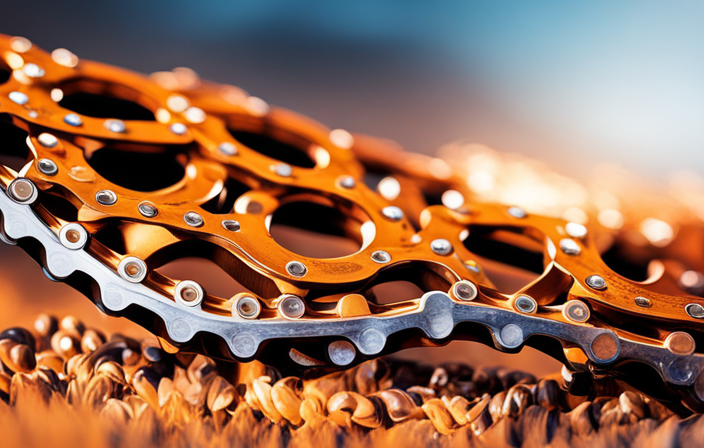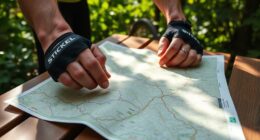Adding a bicycle rack to your car is equivalent to giving a bird wings; it expands the possibilities for adventure and exploration. This article will walk you through the process of installing a bicycle rack on your car, making sure your journey is safe and stress-free.
From determining the type of rack you need to troubleshooting common installation issues, I’ll provide you with the technical knowledge and detailed instructions you need to successfully install a bicycle rack on your car.
Let’s get started!
Key Takeaways
- Check the compatibility of the bike rack with your bicycle and car model.
- Secure the bike properly using straps or clamps before moving.
- Ensure visibility and safety by checking taillights, using reflectors or lights, and maintaining a safe following distance.
- Drive safely by being aware of the added length and width of the vehicle, regularly maintaining and inspecting the rack, and choosing the appropriate size for your car.
Determine the Type of Bicycle Rack You Need
To install a bicycle rack on your car, you’ll need to determine the type of rack you’ll need. Choosing a bike rack depends on various factors such as the number of bikes you plan to carry, the type of car you have, and your preferred mounting style.
There are several options available, including roof racks, trunk-mounted racks, hitch-mounted racks, and spare tire-mounted racks. Roof racks are ideal if you want to maximize your car’s storage space and have a sturdy mounting system. Trunk-mounted racks are easy to install and can fit most car models. Hitch-mounted racks are great for heavy bikes and offer easy access to the trunk. Spare tire-mounted racks are suitable for vehicles with a rear spare tire.
Once you have chosen the right bike rack, you can move on to gathering the necessary tools and materials for installation.
Gather the Necessary Tools and Materials
First, make sure you have all the necessary tools and materials. To determine suitable tools, consider the type of bicycle rack you have and consult the manufacturer’s instructions.
Common tools needed include a wrench, socket set, screwdriver, and measuring tape. Additionally, gather necessary materials such as brackets, straps, and screws that are specific to your bicycle rack model.
Once you have gathered these tools and materials, you will be ready to move on to the next section about preparing your vehicle for installation.
Take note of the specific requirements mentioned in the installation instructions, such as the weight capacity of your vehicle’s roof or hitch. Ensuring you have the appropriate tools and materials is crucial for a successful installation process.
Prepare Your Vehicle for Installation
Before starting the installation process, it’s important to get your vehicle ready. To install a bike rack on different types of vehicles, you need to consider a few factors. First, determine the type of bike rack that is compatible with your vehicle model. Consult the rack’s manual or the manufacturer’s website for this information. Next, clean the area where the rack will be installed, ensuring there is no dirt or debris that could interfere with the mounting process. Additionally, check for any existing attachments or accessories on your vehicle that may need to be removed or adjusted to accommodate the bike rack. Lastly, consider tips for transporting multiple bikes on a car rack. Use bungee cords or straps to secure the bikes and prevent them from rubbing against each other or the vehicle. With these preparations complete, you can now move on to choosing the ideal location for the bike rack.
Choose the Ideal Location for the Bike Rack
Once you have determined the compatibility of your vehicle and cleaned the installation area, you can now consider the ideal location for your bike rack. Finding the perfect spot is crucial for both safety and convenience. Here are three factors to consider when choosing the ideal location:
-
Accessibility: Place the bike rack where it can be easily accessed. Consider the height and accessibility of the rack when mounted on your vehicle. Ensure it doesn’t interfere with opening doors or obstruct the license plate.
-
Stability: Opt for a location that provides maximum stability for your bike rack. Look for areas with sturdy support, such as a trunk or hitch mount. Avoid placing it on flimsy surfaces or areas that may compromise the stability of the rack.
-
Visibility: Ensure the bike rack doesn’t obstruct your rearview mirror or block your taillights. It should not hinder your visibility while driving, especially when changing lanes or reversing.
Once you have chosen the ideal location for your bike rack installation, you can proceed to the next step of installing the bike rack mounting hardware.
Install the Bike Rack Mounting Hardware
To begin, make sure you have all the necessary hardware for mounting your bike rack. The mounting hardware installation is a crucial step in ensuring a secure and stable bike rack on your car.
Start by locating the mounting points on your vehicle’s trunk, roof, or hitch receiver, depending on the type of rack you have. Use the appropriate screws, bolts, or clamps provided with the rack to attach the mounting brackets securely. Make sure to follow the manufacturer’s instructions closely, as each rack may have specific installation requirements. Tighten all the hardware firmly to prevent any movement during transportation.
Additionally, it is essential to check the rack’s weight capacity and ensure it can safely support your bikes.
Once the mounting hardware is securely in place, you can move on to attaching the bike rack arms or rails, which I will explain in the subsequent section.
Attach the Bike Rack Arms or Rails
First, you’ll need to securely attach the bike rack arms or rails to complete the installation process.
To do this, carefully align the arms or rails with the mounting brackets on the bike rack. Ensure that the bike rack is compatible with your vehicle by referring to the instruction manual or consulting the manufacturer’s website.
Once aligned, insert the arms or rails into the brackets and adjust them to the desired position. Some bike racks may have adjustable arms that can accommodate different bike sizes or configurations.
Make sure to tighten any screws or bolts that secure the arms or rails in place, ensuring a secure fit.
With the bike rack arms or rails properly attached, you can now move on to the next step of securing the bike rack to your vehicle, ensuring a safe and stable transportation of your bicycles.
Secure the Bike Rack to Your Vehicle
After attaching the bike rack arms or rails, the next step is to secure the bike rack to your vehicle. This is a crucial step to ensure the stability and safety of your bikes during transportation.
To maximize space and choose the right rack, consider the following points:
- Check the weight capacity of your vehicle’s roof or hitch to ensure compatibility with the rack.
- Select a rack that securely attaches to your vehicle, whether it’s a roof rack, trunk-mounted rack, or hitch-mounted rack.
- Make sure the rack has adjustable straps or clamps that can be tightened to hold the bikes in place.
- Consider additional features like locking mechanisms to protect your bikes from theft.
By following these guidelines, you can choose a bike rack that suits your needs and provides optimal security for your bikes.
Now, let’s move on to the next step and test the stability and security of the bike rack.
Test the Stability and Security of the Bike Rack
Now, it’s time to check if the bike rack is stable and secure. Testing the durability and evaluating the ease of use are crucial steps to ensure a safe and hassle-free journey. To do this, follow the steps below:
-
Durability Test: Apply pressure to the rack from different angles to ensure it stays firmly in place. Check for any wobbling or movement that could compromise the stability.
-
Ease of Use Evaluation: Place a bicycle onto the rack, following the manufacturer’s instructions. Ensure the bike fits securely and doesn’t sway excessively during gentle shaking. Test the rack’s ability to withstand sudden stops and turns without compromising the bike’s stability.
By thoroughly testing the stability and security of the bike rack, you can have peace of mind knowing that your bicycle will be safe during transportation. In the next section, we will discuss how to load and secure your bicycle onto the rack without risking any damage.
Load and Secure Your Bicycle onto the Rack
To safely load and secure your bike onto the rack, make sure to follow these steps.
First, ensure that your bike rack is compatible with your specific type of bicycle. Check the manufacturer’s instructions for any specific guidelines.
Next, carefully lift your bike and place it onto the rack, making sure to balance it evenly. Use balancing techniques such as holding onto the handlebars and supporting the bike at the seat or frame.
Once your bike is positioned correctly, secure it to the rack using the provided straps or clamps. Make sure the straps are tight and the bike is stable before moving on.
Finally, double-check the security of the bike and rack before hitting the road, ensuring that everything is properly tightened and fastened.
Transitioning into the next section, it is crucial to ensure the bike and rack are securely attached to prevent any accidents or damage.
Double-Check the Security of the Bike and Rack
Make sure you’ve double-checked the security of both the bike and rack before heading out.
To ensure the bike rack is properly secured, inspect all the attachment points and make sure they are tightened securely. Check the straps or clamps that hold the bike onto the rack, ensuring they are snug and will not loosen during transportation.
It’s also crucial to confirm that the bike rack is compatible with your specific car model. Consult the rack’s instruction manual or the manufacturer’s website to verify compatibility. Different car models may require specific adapters or modifications to ensure a secure fit.
Once you’ve confirmed the security of the bike and rack, you can proceed to adjust the bike rack for optimal balance and clearance, ensuring a safe and stable ride.
Adjust the Bike Rack for Optimal Balance and Clearance
After double-checking the security of the bike and rack, it is crucial to make balance adjustments and clearance measurements to ensure a safe and stable installation.
Start by adjusting the bike rack to achieve optimal balance. This can be done by positioning the rack evenly on the car and tightening all the straps securely.
Next, measure the clearance between the bike and the car to prevent any potential contact during travel. Ensure that there is enough space between the bike and the car, especially when turning or going over bumps. Use a tape measure or simply eyeball the distance to ensure adequate clearance.
Once you have made the necessary balance adjustments and clearance measurements, you can move on to the next step, which involves ensuring proper visibility and safety measures.
Ensure Proper Visibility and Safety Measures
Ensure that the bike is visible and safety measures are in place.
Proper visibility is essential when transporting bikes on a car rack. Before hitting the road, check that the bike rack does not obstruct any taillights or license plates. Additionally, make sure the bikes themselves are visible by attaching reflectors or lights to the rear of each bike. This will alert other drivers to your presence and prevent accidents.
In terms of safety equipment requirements, it is crucial to secure the bikes properly to the rack using straps or bungee cords. This will prevent the bikes from shifting or falling off during transit. It is also recommended to use a lock to secure the bikes to the rack for added security.
Practice safe driving with a bike rack by maintaining a safe following distance and being aware of the added length and width of your vehicle.
Practice Safe Driving with a Bike Rack
To practice safe driving with a bike rack, it’s important to be aware of the added length and width of your vehicle. This will help you navigate turns and park without causing any damage. Additionally, regular bike rack maintenance is crucial to ensure its functionality and safety. Inspect the rack for any signs of wear and tear, and tighten all connections before each use. Moreover, choosing the right bike rack size is essential to prevent any interference with your vehicle’s rear lights or license plate. Refer to the manufacturer’s guidelines to determine the appropriate size for your car. Remember, following these precautions will help guarantee a smooth and secure journey with your bike rack. Now, let’s move on to the next section about how to remove and store the bike rack when not in use.
Remove and Store the Bike Rack When Not in Use
When you’re finished using it, make sure to remove and store your bike rack in a safe and secure location.
Proper storage of your bike rack is essential to prolong its lifespan and ensure its functionality for future use.
There are various storage options available, depending on the type of bike rack you have.
Wall-mounted racks or ceiling hoists can be used to save space in your garage or shed.
It is important to clean the rack before storage to prevent dirt and debris from accumulating and causing damage.
Additionally, regularly inspect the rack for any signs of wear or damage and address them promptly.
By following these storage options and maintenance tips, you can keep your bike rack in optimal condition.
Now let’s move on to troubleshooting tips and common installation issues.
Troubleshooting Tips and Common Installation Issues
If you encounter any issues or have questions during the installation process, there are troubleshooting tips available to assist you. Here are some common issues that you may come across while installing a bicycle rack on your car and how to resolve them:
| Common Issue | Possible Cause | Solution |
|---|---|---|
| Loose or wobbly rack | Incorrect installation or loose bolts | Double-check the installation instructions and tighten all bolts securely |
| Difficulty in attaching the rack | Incompatible rack or car model | Ensure that the rack is compatible with your specific car model and consult the manufacturer for assistance |
| Bike stability issues | Improper bike attachment or weight distribution | Follow the instructions for properly securing the bikes and ensuring even weight distribution |
| Rack interfering with car functionality | Incorrect positioning or obstruction | Adjust the rack position to avoid interfering with car functions and ensure there are no obstructions |
By following these troubleshooting tips, you can overcome common installation issues and successfully install a bicycle rack on your car.
Frequently Asked Questions
Can I install a bicycle rack on a car with a spoiler?
Yes, you can install a bicycle rack on a car with a spoiler. However, it is crucial to choose the right bicycle rack that is compatible with your car’s spoiler design to ensure a secure and stable installation.
How do I determine the weight capacity of a bicycle rack?
To determine the weight capacity of a bicycle rack, check the manufacturer’s specifications. Factors such as materials, design, and construction determine the rack’s maximum load. Choosing the right bicycle rack involves considering your car’s weight limit and the weight of your bikes.
Can I install a bicycle rack on a car with a trunk-mounted spoiler?
Installing a trunk-mounted bicycle rack on a car with a spoiler has pros and cons. It may obstruct rear visibility but is easy to install. Alternatives include roof-mounted racks or hitch-mounted racks if your car has a hitch receiver.
What are the recommended safety measures when using a bicycle rack?
Proper bike rack installation is crucial for your safety and preventing accidents. Avoid common mistakes like overloading the rack or failing to secure the bikes properly. Follow manufacturer instructions precisely to ensure a secure and stable setup.
Are there any specific instructions for installing a bicycle rack on a car with a sunroof?
When installing a bicycle rack on a car with a sunroof, it is important to choose a rack that is compatible with the sunroof’s opening mechanism. Be cautious to avoid any damage to the sunroof while installing the rack.
Conclusion
In conclusion, installing a bicycle rack on your car can be a straightforward and rewarding process. By following the steps outlined in this guide, you can ensure a secure and efficient installation.
Remember to gather the necessary tools and materials, prepare your vehicle, and choose the ideal location for the bike rack. Pay attention to visibility and safety measures, and practice safe driving with the rack.
Lastly, troubleshoot any issues that may arise and store the bike rack properly when not in use. So, hop on your bike, hit the road, and let your adventures begin!









